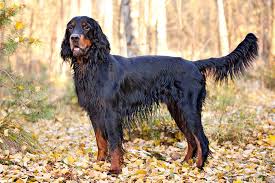The Gordon Setter is a remarkable breed of dog that captivates with its majestic appearance, versatile abilities, and loyal nature. Known for its striking black-and-tan coat, intelligent expression, and medium-to-large build, the Gordon Setter is an impressive sight to behold.
Originally bred in Scotland in the 17th century, this breed has earned a well-deserved reputation as a skilled hunting companion, a loving family pet, and an all-around versatile working dog.
One of the most distinguishing features of the Gordon Setter is its beautiful, glossy coat. The breed’s coat is predominantly black, with distinct tan markings on the chest, legs, and face. The coat is long and silky, offering protection from the elements and giving the dog an elegant appearance. With a well-proportioned, muscular build and a proud carriage, the Gordon Setter exudes an air of confidence and grace.
Beneath its regal exterior, the Gordon Setter possesses a warm and affectionate nature. This breed is known for its loyalty and devotion to its family, making it an excellent choice for those seeking a steadfast companion.
Gordons are typically friendly and gentle with children, forming strong bonds and often assuming the role of a patient playmate. While they are generally welcoming toward strangers, they can also be protective when necessary, making them reliable watchdogs.
The Gordon Setter is an intelligent breed that thrives on mental stimulation and enjoys engaging in various activities. Their intelligence, coupled with their eagerness to please their owners, makes them highly trainable.
However, it’s important to note that the Gordon Setter possesses an independent streak and may exhibit some stubbornness at times. Consistent, positive reinforcement training methods that incorporate treats, praise, and rewards tend to yield the best results.
Originally bred as hunting dogs, Gordon Setters have retained their exceptional abilities in the field. They have a keen sense of smell, excellent tracking skills, and an instinctive drive to hunt game birds. These attributes make them well-suited for activities such as hunting, field trials, and scent work. Additionally, their athleticism and endurance enable them to excel in various dog sports, including agility, obedience, and rally.
As an active and energetic breed, the Gordon Setter requires regular exercise to maintain its physical and mental well-being. Daily walks, play sessions, and opportunities to run off-leash in a secure area are essential for preventing boredom and ensuring a contented dog. The breed’s long coat needs regular brushing to keep it free from tangles and mats. It’s also important to check and clean their ears regularly to prevent ear infections.
In addition, the Gordon Setter is a magnificent breed that combines beauty, intelligence, and loyalty. Whether as a hunting companion, a family pet, or a versatile working dog, Gordons excel in all they do. With their regal presence, affectionate nature, and impressive capabilities, the Gordon Setter is a cherished companion for those who appreciate the unique qualities this breed has to offer.
Read Also: Important Considerations in Rearing Poultry Chickens
History and Origin of the Gordon Setter Dogs

The history and origin of the Gordon Setter can be traced back to Scotland in the 17th century. The breed was named after the fourth Duke of Gordon, Alexander Gordon, who played a significant role in its development. The Duke was a passionate sportsman and dedicated himself to breeding and refining a specific type of hunting dog that would excel in the field.
The exact origins of the Gordon Setter are somewhat uncertain, as there is limited documentation from that era. However, it is widely believed that the breed was created by crossing various Scottish hunting dogs, including the Scottish Setter, with other breeds such as the Bloodhound and the Irish Setter. The goal was to produce a dog with exceptional scenting abilities, stamina, and a keen sense of tracking.
The Duke of Gordon’s breeding program focused on producing a distinct type of hunting dog with a black-and-tan coat, which would make them easily distinguishable from other hunting dogs during a hunt. Over time, the breed’s appearance, temperament, and hunting skills were refined through selective breeding.
The Gordon Setter gained recognition as a distinct breed in the mid-19th century. In 1862, the breed was officially recognized by the Kennel Club in the United Kingdom. It was also one of the original breeds registered by the American Kennel Club when it was founded in 1884.
Initially, the primary purpose of the Gordon Setter was to assist hunters in locating and retrieving game birds, particularly grouse. The breed’s exceptional scenting abilities, endurance, and determination made them highly valued as hunting companions. However, over time, their popularity expanded beyond hunting circles, and they became sought after as family pets and show dogs due to their striking appearance and affectionate nature.
Today, the Gordon Setter remains a versatile breed that excels in various roles. While they are still used as hunting dogs in some parts of the world, they are also cherished as loving and loyal family companions. Their intelligence, trainability, and athleticism make them well-suited for various dog sports and activities, further showcasing their versatility.
The breed’s rich history and its connection to Scottish heritage have contributed to its enduring popularity. The Gordon Setter continues to be admired and celebrated for its regal presence, exceptional hunting skills, and unwavering devotion to its family.
Health Issues and Lifespan of Gordon Setter Dogs

The Gordon Setter is generally a healthy and robust breed. However, like all dogs, they can be prone to certain health issues. It’s important for potential owners to be aware of these conditions to ensure they can provide appropriate care and monitor their dog’s health. Here are some of the common health issues seen in Gordon Setters:
Hip Dysplasia: Hip dysplasia is a hereditary condition that affects the hip joints. It occurs when the hip socket and thighbone do not fit properly, leading to degenerative changes and discomfort. Regular exercise, maintaining a healthy weight, and responsible breeding practices that include hip evaluations can help reduce the risk of hip dysplasia.
Progressive Retinal Atrophy (PRA): PRA is an inherited eye disorder that causes progressive degeneration of the retina, eventually leading to vision loss and blindness. Regular eye examinations by a veterinary ophthalmologist can help identify PRA and enable early intervention and management.
Hypothyroidism: Hypothyroidism is a condition in which the thyroid gland does not produce enough thyroid hormones. Symptoms may include weight gain, lethargy, hair loss, and skin issues. This condition can often be managed with medication prescribed by a veterinarian.
Gastric Dilatation-Volvulus (GDV): Commonly known as bloat, GDV is a life-threatening condition that affects deep-chested breeds like the Gordon Setter. It involves the stomach filling with gas and twisting on its axis, leading to a potentially fatal situation. Feeding multiple small meals, avoiding exercise immediately after meals, and feeding from elevated food bowls can help reduce the risk of bloat.
Canine Cataracts: Cataracts are the formation of opacities in the lens of the eye, leading to vision impairment. While not always hereditary, some Gordon Setters can be prone to developing cataracts. Regular eye examinations can detect cataracts and allow for appropriate management or surgical intervention if necessary.
The average lifespan of a Gordon Setter is typically around 10 to 12 years. However, with proper care, a healthy diet, regular exercise, and routine veterinary check-ups, some individuals may live longer.
It’s important for potential owners to work with reputable breeders who prioritize health testing and follow responsible breeding practices. Regular veterinary care, a balanced diet, exercise, and a loving environment are key factors in promoting the overall well-being and longevity of a Gordon Setter.
Read Also: Newfoundland Puppies: Description and Complete Care Guide
Gordon Setter Dog Breed Complete Grooming and Care Guide

Grooming and care are essential aspects of keeping your Gordon Setter healthy, comfortable, and looking their best. Here’s a complete guide to grooming and caring for your Gordon Setter:
Coat Care:
Brushing: The Gordon Setter has a long, silky coat that requires regular brushing to prevent matting and tangling. Use a slicker brush or a pin brush to remove loose hair and keep the coat in good condition. Brushing a few times a week is usually sufficient, but during shedding seasons, daily brushing may be necessary.
Bathing: Bathing should be done as needed, typically every 6 to 8 weeks or when the dog gets dirty. Use a gentle dog shampoo and ensure thorough rinsing to prevent skin irritation. Avoid over-bathing, as it can strip the coat of its natural oils.
Ear Care: The Gordon Setter’s long, floppy ears are prone to ear infections. Check the ears regularly for signs of redness, odor, or discharge. Clean the ears with a veterinarian-recommended ear cleaner and gently wipe the outer part of the ear with a soft cloth. Avoid inserting anything deep into the ear canal to prevent injury.
Nail Trimming: Trim your dog’s nails regularly to maintain proper foot health. Use a dog nail clipper or grinder, and be cautious not to cut into the quick (the sensitive part of the nail). If you’re unsure or uncomfortable with nail trimming, consider seeking assistance from a professional groomer or veterinarian.
Teeth and Oral Care: Dental hygiene is important for overall health. Brush your Gordon Setter’s teeth regularly using a dog-specific toothbrush and toothpaste. Additionally, provide dental chews or toys that help reduce tartar buildup.
Exercise and Mental Stimulation: The Gordon Setter is an active breed that requires regular exercise to stay physically and mentally stimulated. Aim for at least one to two hours of exercise each day, which can include brisk walks, jogging, playing fetch, or engaging in dog sports like agility or obedience training.
Mental stimulation is equally important. Provide puzzle toys, interactive games, and training sessions to keep your Gordon Setter’s mind engaged and prevent boredom.
Nutrition: Feed your Gordon Setter a high-quality, balanced diet that meets their specific nutritional needs. Consult with your veterinarian to determine the appropriate portion sizes and feeding schedule based on your dog’s age, weight, activity level, and any specific dietary requirements.
Avoid overfeeding, as Gordon Setters can be prone to weight gain. Obesity can lead to various health issues and put unnecessary strain on their joints.
Veterinary Care: Schedule regular veterinary check-ups to monitor your Gordon Setter’s overall health and catch any potential issues early. Vaccinations, parasite prevention, and routine blood work are important aspects of preventative care.
Discuss with your veterinarian the appropriate vaccination schedule, spaying/neutering, and any breed-specific health concerns.
Training and Socialization: The Gordon Setter is an intelligent breed that thrives on positive reinforcement training methods. Start training early, be consistent, and use rewards such as treats, praise, and playtime to motivate your dog.
Socialize your Gordon Setter from a young age by exposing them to various environments, people, and other animals. Proper socialization helps develop a well-rounded and confident adult dog.
Remember to provide your Gordon Setter with plenty of love, attention, and a stimulating environment. With proper grooming, care, and nurturing, your Gordon Setter will thrive as a happy, healthy, and well-rounded companion.
Read Also: Collective Farming: The Key to Sustainable Food Systems





